Flag: the history of the American symbol
All countries have state flags. You can forget the words of the hymn, it is difficult to depict the components of the coat of arms, but from early childhood we remember the flag of our homeland. He accompanies us everywhere; on houses and stadiums, at memorials and state institutions, at conferences and congresses, in the quiet of offices and at parades, on flagpoles of ships and in news television programs. Millions of people are proud of their state flags. Only among the countries of the UN, their number is close to 200. Therefore, it is extremely difficult to remember everything. True, there are among them easily recognizable. For example: the square Swiss flag, as well as the flag of the International Committee of the Red Cross emanating from it. Known around the world and the American state flag, with 13 horizontal alternating red and white stripes and the upper dark blue kryzhem depicting 50-ti five-pointed white stars. One of the main symbols of the United States of America.
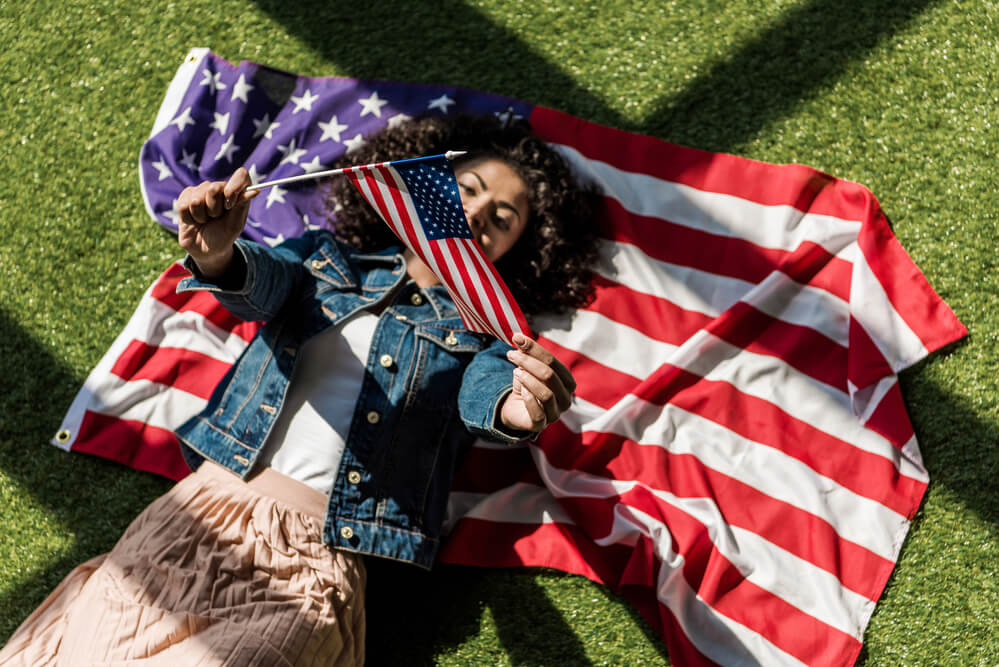
Photo: depositphotos.com
The number of flags in the world is so large that it is difficult to calculate. After all, in addition to the state, there are also naval and trade flags. In addition, within the states themselves, individual flags have separate regions: states, lands, provinces, cantons, provinces, departments, etc. The flags of historically departed or newly formed formations also function there. Let's say there are still places in the USA where flags of the Confederation are hung out. We should not forget that they exist in every city and municipal union. But there are after all not only administrative formations. A special place here is occupied by sports organizations, where every club and even a team in all sports has its own flag. Not to mention numerous international organizations and national movements: the UN, the Olympic Committee, various ethnic flags, etc. The flags of social movements such as pacifists, homosexuals, etc. occupy a special place. The flags of numerous commercial organizations and a great number of banners and Church banners.
Let's try to understand their differences. First - the banner from the flag. The fact is that while the latter can be produced in large, even industrial volumes, the banner is always individual. Let's say there is a regimental banner, or a division banner. There cannot be several of them. As a rule, banner panels are made from two pieces of fabric sewn around the perimeter, differing in appearance and possible inscriptions. Made from expensive materials (velvet, satin, brocade), they are usually decorated with ribbons, embroidery, fringe or tassels, and attached with special nails to a shaft decorated with a pointed tip. It is customary to store banners in a case, and only specially trained standard bearers have the right to carry and unfurl them. Thus, banners are, as it were, the official “face” of certain organizations.
If we are talking about representing a specific position or post with a flag, then it automatically turns into a standard. We are familiar with the “presidential standard” as a symbol of power. There are also many different modifications of flags, which include a pennant, badge, flag, canton or weather vane. But this is already more interesting for sailors and specialists. And now we will pay attention to the differences in their color scheme. Of course, there are also monochrome ones among them. Everyone knows about the white flag, which, according to the Geneva Conventions, serves as a sign of truce, either as an offer for negotiations or surrender. And black is usually associated with the Jolly Roger, a pirate flag that features a skull and crossbones.
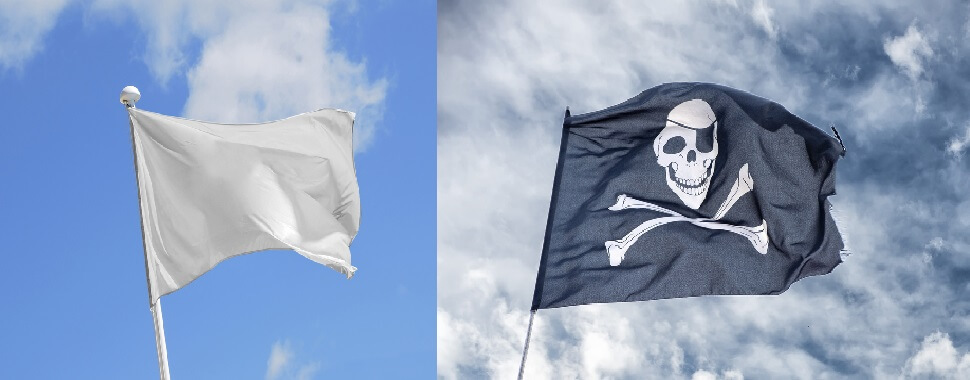
Photo: depositphotos.com
We are well acquainted with the revolutionary red flags of the Soviet Union, China or Vietnam with the corresponding star attributes. But most often the flags are still made multi-colored, with vertical or horizontal arrangement of the respective lanes. Among them are the same: red-white in Monaco and Poland, or red-white-blue tricolors of Russia and the Netherlands, but with a different arrangement of bands. Although there are many possible options.
The design of flags can be jagged (where two colors are separated by a zigzag edge), bordered (in which the main color is surrounded by another color), or, like the St. Andrew's flag, divided into four equal sections, etc. In this sense, the flag of Norway is especially interesting, which is called the "mother of all flags" because it includes the flags of Indonesia, Poland, Finland, France, the Netherlands and Thailand.
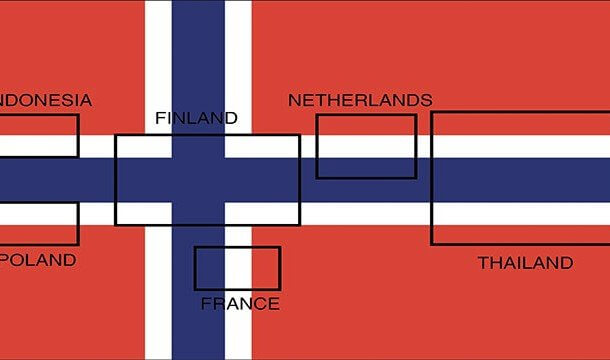
Author's infographics
The flags of the British Overseas Territories are very similar, differing from each other only in their coats of arms. Most often on flags you can see an image of the sun or a Scandinavian cross, or elements that in some way reflect the history and culture of states. Although most national flags feature a variety of geometric shapes and common symbols, there are flags with incredibly exotic designs. For example, on the flag of Mozambique there is a Kalashnikov assault rifle, Cyprus transferred the map of the island to it, and the flag of Cambodia is very convenient for tourists: it depicts the main attraction of the country - the Angkor Wat temple. The flag of Benin shows a naked man with a sword beheading another, and the flag of Wales shows a dragon. By the way, images of birds and animals can be seen on the flags of many countries: Mexico - a golden eagle, Uganda - a crane, Zambia - an eagle, Sri Lanka - a lion, Moldova - a bison's head, Belgian Wallonia - a rooster, Chelyabinsk region - a camel. City St. Petersburg in Florida chose a white pelican, Berlin a bear, and Hanover a white horse.
There are also images of plants on the flags. The most famous of them is the maple leaf on the Canadian flag. In Cyprus we see olive branches, in Brussels - iris, in Equatorial Guinea - a cotton tree, in Mexico - a cactus. You can watch these and many other interesting facts and stories related to flags in the video show “Fun Flags with Shelton Cooper.” The fact is that the host of this series, the talented American comedian Jim Parsons (known for the film “The Big Bang Theory”) is an ardent fan of vexillology: a historical science that studies all types of flags and banners, their shapes, components, heraldic or symbolic signs and compositions flowers, establishing the origin and evolution of their development. The books of the American flag expert Whitney Smith, translated into almost all European languages, also contributed to the widespread popularization of vexillology. This word itself comes from the Latin "vexillum"(banner), the ancient Roman name for the predecessor of modern flags - “vexilum”, a small panel attached with its upper edge to a horizontal pole. Combined with the Latin “logos” (“word” or “teaching”), it formed the term vexillology, which is now used as an international term. Of course, the Romans were not the first to use flags. This was preceded by their
Centuries-old history
But, strange as it may sound, it originated with superstitions. Our ancient ancestors believed that some animals or birds could become their protectors and contribute to good luck in the hunt. They painted their images on the walls of caves, and when going hunting, they often took with them a pole with images of figurines of chosen deities. In addition, the location of fellow tribesmen could be easily determined by the high pole. This custom was subsequently used by ancient civilizations. It is known that in Ancient Egypt, already about five thousand years ago, during campaigns, warriors carried long poles with special badges-symbols of their units, which were crowned with a figurine of a falcon, a deity recognized in Egypt. Assyrian warriors attached a disk with an image of a bull, or two, but interlocking horns, to the end of a long pole. Among the Ancient Greeks, this tradition received even greater development: any city, people or state could be identified by their chosen holy animal or bird: the owl was the symbol of Athens, the galloping horse - Corinth, the bull - Boeotia. The Romans adopted it from the Greeks. The tails of animals, bundles of hay, and various metal badges were attached to the signums, as the symbols of the Roman legion were called. In 104 BC. Consul Marius officially decreed that the sign of the Roman legion would henceforth be the image of an eagle.
For a long time, the eagle was a totem among the peoples of Asia, then the ancient Persians, Greeks, and later the Romans adopted this tradition from them. A kind of proof of this is a unique artifact: the oldest flag in the world, made in the third millennium BC. It was discovered in Shahdad, an ancient region of Iran, and is now kept in the National Museum of Tehran. This ancient “Shahdad flag” is a plate measuring 22 by 22 centimeters, made of an alloy of copper with other metals and an admixture of arsenic. It was engraved with ancient symbols, and the flagpole was topped with an eagle figurine. The first Roman banners differed from modern ones in that their purple panels were not attached to the pole, as they are now, but hung vertically from a small crossbar nailed to a long pole. The Chinese were the first to attach the panel not to the crossbar, but directly to the shaft. They also replaced the heavy and rough cloth of the Romans with Chinese silk. Around 100 BC e. In China, they began to use this lightweight and durable fabric, then unknown in Europe, the cloth of which was easily painted and fluttered, fluttering even in a light wind. And the bright figures depicted on it seemed alive and were easily distinguishable from afar.
It is believed that it was during those times that the tradition of using banners in military campaigns arose, although in China they were also used to organize religious processions in temples. The Arabs were the first to adopt it: the founder of Islam, the Prophet Muhammad (c. 570 - 632), went on campaigns only under the banner. First under black, and then under green, which has since been considered the “color of the prophet.” During the Crusades to the Holy Land (1189th–XNUMXth centuries), European knights also became acquainted with these Arab customs. Soon, flags also appeared over their castles and estates, but with their family coats of arms. And in XNUMX, before the start of the third crusade, it was decided that the German emperor Frederick I Barbarossa, the French king Philip II Augustus, the Austrian Duke Leopold V and the English king Richard I the Lionheart, who led it, would go on a campaign under their own banners . This was caused not so much by serious contradictions between them, but by different ways of advancing their armies to the Holy Land.
However, the flag of Denmark is considered to be the first officially recognized national flag. An interesting legend is associated with its appearance. As if at the beginning of the 13th century, the Danish king Valdemar II organized a campaign against the pagan Estonians. They decided to use a trick: having agreed to make peace and be baptized, they suddenly treacherously attacked the Danes. Taken by surprise, they began to retreat. At this time, their king saw a white cross in the evening sky, stained by the sunset. And soon, into the hands of the archbishop praying for the army, the “Dannebrog” (“flag of the Danes”) fell from the sky.
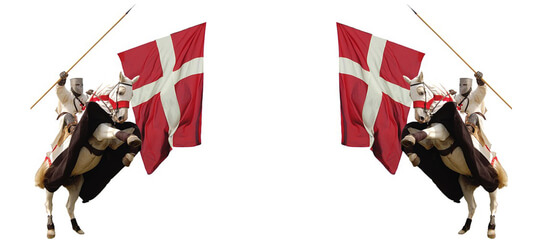
Photo: depositphotos.com
Perceiving this miracle as a sign of God, the Danes cheered and crushed the enemy. This happened 15 June 1219 of the year. Since then, every year on this day, in the Tallinn Garden of the Danish king, Dannebrog's birthday is celebrated. And the figure of an iron knight installed there, with a sword and a red and white shield stylized to the colors of the Danish flag, indicates the place where the flag descended to the ground. Similar legends related to the origin of national flags exist in many countries. For example, the Austrian flag consists of three equal-sized bands: red, then white, and again red. It is believed that during the third Crusade the Austrian duke Leopold V fought so hard against the Saracens that he was wounded, and his white marching form was covered with blood. But when he took off the belt, it turned out that no blood had penetrated under him, and a white stripe was preserved in the middle of the form. The Duke liked these colors so much that he later transferred them to his standard. And in 1230, the Duke Frederick II approved this combination of red and white as the flag of Austria.
In Germany, they love to tell the story of how, during the Napoleonic wars, German volunteer students formed the so-called “corps of freedom” under the command of von Lutzoff. His uniform became student black frock coats with embroidered red shoulder straps and brass buttons. It is assumed that these colors: black, red and gold, were then included in the composition of the German national tricolor. There are similar legends about the American flag. At least, the story of 3 August 1777 was well known when the British were sent to Fort Schuyler (near New York) by reinforcements from Massachusetts besieged by the British. His fighters brought with them the news of the decision taken by Congress to establish the official flag of the United States 13. The decree was, but the flag itself was not yet. And then the soldiers urgently sewed him from the white shirts torn to stripes, the red flannel skirts of the officers' wives, and the blue coat of Captain Abraham Svartouth (Abraham swartwout) and then raised it over the fort. The credibility of this story is confirmed by a voucher of Congress, which returned to the captain the value of his coat, used to produce the flag. True, we are not talking about the idea of creating the flag itself, but about an unusual form of its implementation.
And yet, in many countries of the world, flags were originally used at sea, and then on land. The first signs of ownership and nationality of ships were emblems or coats of arms drawn on the sails of the ship. The same purpose was served by coat of arms, attached along the gunwires. But gradually they were driven out by real state flags. From this began and
History of the American State Flag
So, in 1776, the II Continental Congress adopted the US Declaration of Independence. The new state includes 13 territories, former colonies of Great Britain: Virginia, Delaware, Georgia, Massachusetts, Maryland, New Hampshire, New York, New Jersey, Pennsylvania, Rhode Island, Connecticut, South Carolina and North Carolina. This document summarized the struggle that has been going on for many years. Suffice to recall the “Boston slaughter” in March 1770, when British soldiers in Massachusetts opened fire on an unarmed crowd, or “Boston tea drinking”, in which 16 December 1773, in response to the actions of the British government in the Boston harbor, the cargo was destroyed teas of the British East India Company. All these years, the ships belonging to the colonies dissatisfied with their position, nevertheless, carried out trade and military operations. But under what flag? It is believed that they went under the so-called. A continental flag that was a slightly modified copy of the flag of the British East India Company. The only difference was that they, retaining 13 red and white stripes, a rectangular kryzh (top of the flag flag at the flagpole) with the image of the British "Union Jack" (Union Jack) was replaced by a square one. This is easily explained - after all, at that time no one even thought about complete separation from Great Britain. This Continental Flag was commonly known as Grand union flag - The flag of the Great Union, the Cambridge flag or the flag of the Congress.
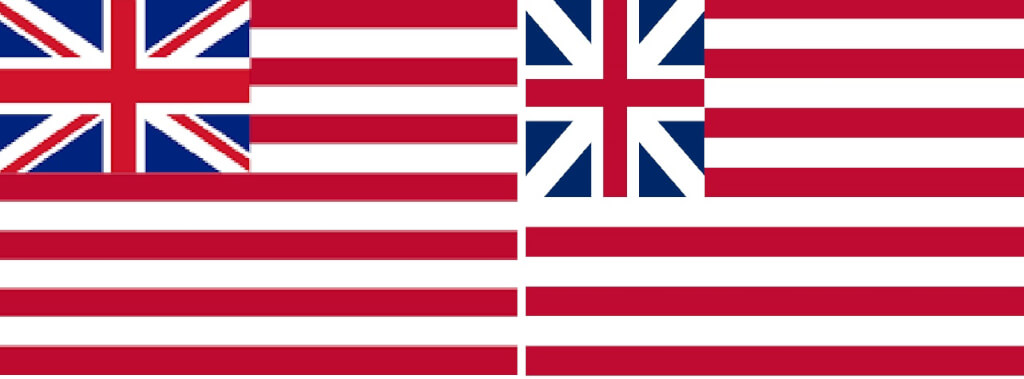
The flag of the East India Company and the Continental Flag. Photo: depositphotos.com
It is believed that for the first time he was raised on December 2 1775 by Lieutenant John Paul Jones on the ship "Alfred" in the harbor of Philadelphia. It is also known about the use of the Gadsdenovsky yellow flag in those days with the image of a rattlesnake coiled and ready to bite and the text under it: “Don't step on me.” Or the flag "Tree of Freedom", with the image of a lonely green pine on a white background, sometimes with the words "Appeal to Heaven." Like the flag of Bedford, with the arm raising a sword chained in the armor, and the Latin inscription “Win or die”. There were many more options. B. Franklin, who accepted the post of US ambassador to Paris, even received a request from the Sicilians with a request to inform them about the flag under which foreign ships should enter American ships? It was necessary to make a final decision on the country's uniform national flag.
And on June 14, 1777, Congress finally approved it. This day in the United States will later be celebrated as Flag Day. The resolution stated: “The flag of the 13 United States consists of 13 alternating stripes of red and white and 13 white stars on a blue field, representing a new constellation.” And George Washington explained the design in his own way: “We took the stars from heaven, red is the color of our homeland, the white stripes that divide it mean that we have separated from it; and these white stripes will go down in history as a symbol of freedom.” Now it was time to create the flag design. This was done by Francis Hopkinson (Francis Hopkinson) was one of the Founding Fathers, a lawyer who signed the Declaration of Independence as a delegate from New Jersey. He acted simply, taking the Continental flag as a basis. Moreover, there was no need to explain where 13 stripes appeared on the flag of the East India Company: all these stories about the Freemasons, the meaning of the number 13, and the fact that the murder of the Templars was carried out on Friday, October 13. Here everything was clear: after all, the number of colonies that signed the Declaration was also 13, which means that the alternating red and white stripes could be preserved. Now the question of the roof has arisen. Hopkinson replaced the image of the British Union Jack with a starry sky, depicting the same 13 white stars (states) on a blue sky. And if “we took the stars from heaven,” then it was logical to make them 6-pointed, that is, biblical, or Bethlehem. These stars, by the way, will then appear in the first edition of the coat of arms, and later on the chests of the sheriffs. Hopkinson's appeal to Congress with a request to pay for it can serve as confirmation of the work he performed. But the payment was never made. On the one hand, because he simply fulfilled the instructions of Congress, for which he received the corresponding salary of a congressman. On the other hand, many flags made later did not quite match his design. According to his idea, the stars in the roof were to be arranged in rows, and they were placed in a circle, or in a semicircle with the number 76 - the year of the Declaration of Independence, and in other variants. Additionally, the 6-pointed stars have been replaced with 5-pointed ones. But why and by whom was this done? Presumably, by D. Washington himself. An indirect confirmation of this can be the widespread legend about the seamstress Betsy Ross (Betsy Ross).
Allegedly, members of a certain commission of Congress came to her workshop at the beginning of June 1766, with a proposal to make a flag. Among them was well-known to her, General Washington, who attended the same church with her and used her services before, as well as financier Robert Morris and her husband's uncle (representative of Pennsylvania) Colonel Ross. She immediately agreed, but made a few comments: the flag should be made not square, but rectangular and six-pointed stars should be replaced by pentagonal, t. because they are easier to make. J. Washington immediately agreed with her suggestions and corrected the drawing. Probably, he recalled then what form the Continental flag has, and that 5-final stars shine on his family coat of arms. Then they carried this modified draft to Congress, where it was reviewed. And the next day, Colonel Ross announced that her changes had been approved, and she could start work. Thus, according to legend, Betsy Ross made the first Allied flag and then for many years produced flag banners for the US government. This story at the meeting of the Historical Society of Pennsylvania in March 1870 of the year was reported by her grandson William Canby, confirming only with the testimony of his family members. If at another time this message was simply not paid attention, or ridiculed, then now it has fallen on fertile soil. Philadelphia was preparing to celebrate the centenary of the United States, and such a heroine suited them in all respects. Because this story immediately hit the newspapers, magazines and children's books. And it has become so popular and famous that no one even thinks about its authenticity. But in the documents of the Congress for this period it was not possible to find any references or references to the existence of any committees to create a flag, meetings to review its design, and even less approval. There are no documents on agreements with Betsy to make flags for the Congress in the future. And the visit of famous guests to it is doubtful. Imagine a situation: a military general, busy on the fronts of the revolution and torn between Boston and New York, J. Washington takes time to create not only sketches of the flag, but also visits to a seamstress. What, it was impossible to send someone simpler? And the fact: he draws 6-final stars and comes to Betsy, so she talked him out? And he, the state husband, cares about how much time a seamstress spends cutting stars? Not to mention that Washington at that time was not at all in Philadelphia. And why was Betsy and her relatives silent about this event for more than 100 years? But now it all does not matter. In school textbooks and textbooks for passing on American citizenship, this story is presented as an absolute reality. In Philadelphia, bought the house where she lived. And now every guest of this city will certainly visit it. Dozens of artists depicted her meeting with Washington and working on the flag, and in 1952, in honor of the 200 anniversary of the birth of Betsy Ross, a special three-cent label was issued. So she turned into a kind of symbol, despite the fact that at least 17 people could claim the right to be called a seamstress who made the first American flag.
A curious story happened to the same captain John Paul Jones in 1779. During the sea battle, he captured the British frigate "Serapis", on which the flag was torn off and carried away by the wind.
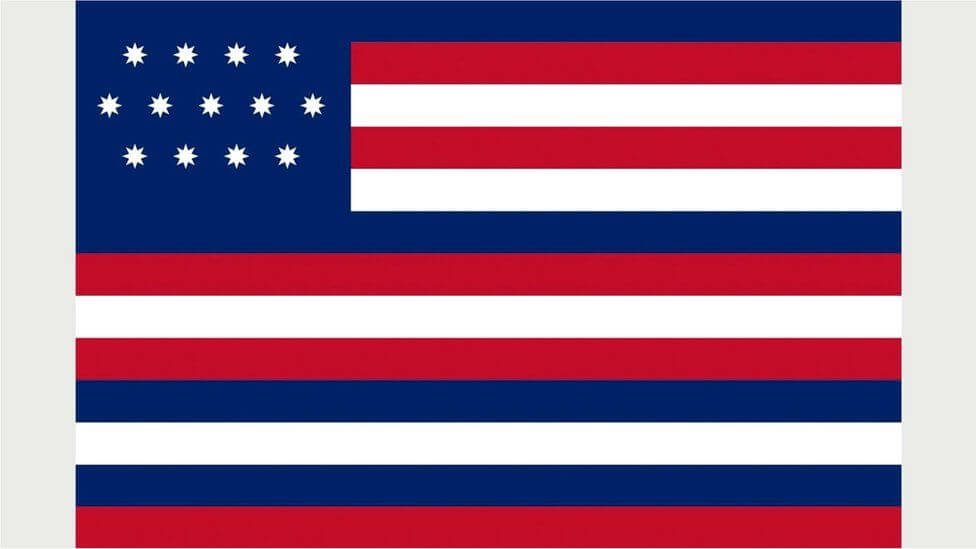
Flag of Serapis. A photo: Wikipedia Public Domain
When Jones brought it to the Dutch-owned port of Texel for repairs, the frigate was declared a pirate. It looked like a pirate ship - without a flag. And then, so that the Dutch would believe that the ship belonged to the United States, Jones strained his memory and made a standard of 13 stripes and 13 stars. It turned out not very similar to the already accepted design, but the Dutch were happy with it. Since then it has been called the “Flag of Serapis”. Since those ancient times, the number of stars on the flag has changed 26 times.
The next time this happened in 1795, after joining the state of Vermont and Kentucky. Assuming that the colony integration is already completed, it was decided to increase the number of bands and stars from 13 to 15, placing them horizontally on the roof in 5 rows, with 3 in each. It was this, with 15 stars and stripes, that he was seen by lawyer and poet Francis Scott Key on 13 on September 1814 of the year when British ships attacked Fort McHenry in Baltimore. Despite the fierce shelling, the fort stood, and early the next morning, Francis saw that the US flag was still flying over him, and not the British Union Jack. Delighted with the fortitude and courage of the defenders of the fort, he immediately wrote the poem Defense of Fort McHenry. Her lines, set to music, were so loved by everyone that the song was soon used in the Navy, and since March 3, 1931 was declared the national anthem.
"See if you see the first rays of the sun,
What is the sunset with the eyes we lost our eyes?
Oh, tell me, he's alive, our striped flag,
The colors of the sky and the sun is our starry banner? ...
Above the land of the free, the homeland of the brave? "
Since then, he became known as Star-Spangled Banne (Star Spangled Flag). And it existed in this form until 1818. From that moment on, the number of states joining the union began to increase, and Congress decided to return to the original 13 stripes, but the number of stars had to correspond to the number of states in a single union. On April 4, 1818, a law was passed, signed by President Monroe, which provided for a flag with 13 stripes, and in the case of registration of a new state, on the Fourth of July, the addition of an additional star to the top.
There is another American flag, which became famous under its own name. it Old glory (Old glory). It is believed that in 1831, Captain William Driver called the flag of his whaling ship "Charles Doggett." He was badly battered by the sea winds, faded from the bright rays of the sun, but, nevertheless, the captain took him for many years to sail and saved him from confiscation by the Confederation authorities during the civil war. After graduation, William posted the “Old Glory” flag on the capitol spire in Tennessee. Federation soldiers enthusiastically greeted him. Many newspapers wrote about this episode, and the flag soon became famous. Nowadays “Old Glory”, as well as “The flag covered with stars”, is kept in the National Museum of American History, in Washington (DC).
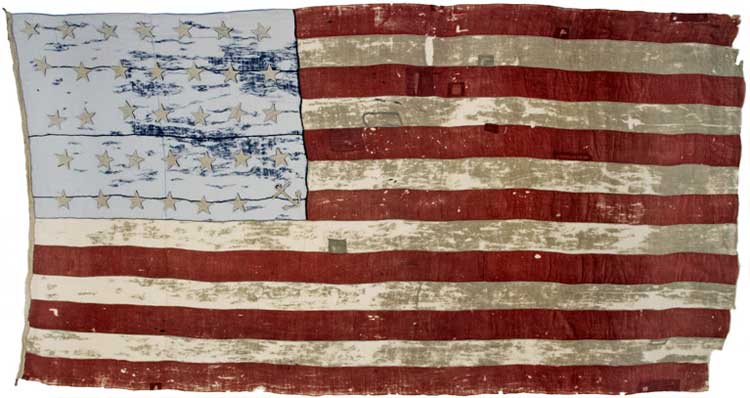
Flag Old Glory (Old Glory). Photo: depositphotos.com
In the 1863 year, after the annexation of West Virginia, 35 stars appeared on the US flag. In fact, it was under this flag that the war between the North and the South ended.
And only in 1913 year, when the flag has already changed 24 times, and counted 48 stars, for the first time special documents and specifications were approved, regulating its proportions, size and color bands. For example, it was then that the ratio of the height to the length of the flag panel was established, like 1: 1,9, etc. By that time, the issue of the need for a special holiday was debated in the country for almost 30 years. Stars and Stripes (Star-Striped Flag), or “Flag Birthday”. At first, the initiators were ordinary school teachers B.J. Sigrand from Wisconsin and George Balch from New York. Then this idea was picked up in Philadelphia, New York and in the state of Chicago. In connection with the holding of such holidays in different states and parts of the country, in 1916, he was officially proclaimed President Woodrow Wilson. And on August 3, 1949, now President Truman, signed the Act of Congress, which finally approved June 14 Flag day - National Flag Day. Since then, every year on this day, US residents decorate their homes with flags, thereby showing their patriotism. The flag, whose birthday they began to celebrate, had already celebrated its 172nd anniversary by that time and, having been approved in 1912, will serve until 1959. And since we are already talking about patriotism, it should be noted that it was under this flag that American soldiers went into battle during the First and Second World Wars. Therefore, here it is impossible not to mention the events of the American-Japanese War and the famous photograph “Raising the Flag over Iwo Jima” (Raising the Flag on Iwo Jima), performed by 23 February 1945, a military journalist and photographer Joseph Rosenthal.
It depicts five marines and a medical officer of the US Navy, raising the country's flag on the top of Mount Suribati during the Battle of Iwo Jima at the end of World War II. The seizure of the island, where Japanese airfields and air bases were located, was of great strategic importance for Americans. After four days of fierce fighting, a division of marines made its way to one of the volcanic peaks of the island of Iwo Jima and hoisted the American flag on it. This photo, reprinted by thousands of newspapers and magazines, immediately gained immense popularity. Later, she became the only one in the year of publication of the frame that won the Pulitzer Prize for an outstanding photo. And in the US, this snapshot was one of the most significant and recognizable images of war, and the most frequently reproduced in reproductions of photographs of all time.
But back to our retrospective. In 1923, a special Codex of the flag appeared in the United States, which regulates the rules and traditions of handling this symbol of the American state. In 1943, he received the status of federal law. It reflects the rules of handling and hanging, both the flag itself and the lowered one, special days for hanging, an indication of what is prohibited to do with the flag, as well as a place of permanent hanging. It is curious that in addition to the most important public buildings in the country, it was also located at the South Pole, and on the surface of the Moon. American flags were placed there by astronauts of the Apollo-11,12,14,15,16 and Apollo-17 spacecraft. True, the flag set by the Apollo 11 crew was overturned by the exhaust when the ship took off for lunar orbit, so five American flags are now installed on the Moon.
Now go back to 1958 year. Then the question of the possible admission of Alaska and Hawaii to the USA was widely debated in the country. But what should the flags of these flags look like, if they are attached? The US Congress received more than 1500 proposals, both 49 and 50 star flags. On this wave, a history teacher at a school in Lancaster (Ohio) gave his students a homework: to come up with a flag design. One of them, 17-year-old Robert Heft (Robert G. Heft), for the proposal he submitted, he received a four with a minus. What was very dissatisfied. Entering a sharp controversy with the teacher, he received the appropriate answer: the assessment can be changed only if approved by the Congress of his work. And then Robert not only sent his work to the competition, but also won it. So in 1960-th year, after the accession of Hawaii, the flag came out already with its design, and exists in this form to this day. In recent years, however, there have been reports that the District of Columbia, Puerto Rico, and others are claiming the right to become an 51 state. But their time has not come yet. And the new Robert Heft is probably still preparing to go to school.
And in 1961, President John F. Kennedy signed a decree stating that from now on the national flag of the United States will also have to be hung out on the flag of the Marine Corps Memorial, and be there around the clock for 24 hours a day. Along with such significant public buildings and services of the country as the White House, Washington Monument, National Memorial Arch in Pennsylvania, state border crossing points, etc. All this happened because the completion of the construction of this Memorial in 1954 year, near the walls of Arlington National Cemetery (in the suburbs of Washington), received a huge response, both within the country and abroad. In fact, he was the embodiment in bronze of the famous photography by the journalist Joseph Rosenthal, already mentioned by us, “Hoisting the flag over Iwo Jima”.
The fact is that the sculptor Felix de Velden, who was then serving in the US Navy, was so touched and admired by this photograph that he immediately made several plaster copies of it and showed them to his superiors. This story ended with the fact that ultimately, he was tasked with erecting a war memorial complex, representing six soldiers (H = 9.8 m.), frozen in incredible effort while hoisting a flag on a block of black granite (H = 4.5 m.), reminiscent volcanic rock of Iwo Jima Island. If we look closely at the faces and frozen figures of these soldiers, we will see with what difficulty and determination, overcoming the wind at the top and the weight of the huge canvas, they, intercepting and passing the flagpole to each other, raise this flag higher and higher. And we understand that for them this is not just a flag of Victory, raised as a sign of the end of the battle, but something much more. It was difficult to imagine that it was even possible to capture this impregnable island, but they did it. And they hoisted over him the stars and stripes flag of their country, for which they were ready to give their lives, to the last drop of blood. Three of them will remain on this earth forever, and the battle for Iwo Jima will become the bloodiest operation in the history of the US Marine Corps. “Incredible Valor was their common Dignity,” Admiral Chester Nimitz would say of them.
A slightly different perspective on the awareness of the role and significance of the national flag is presented at the Museum of Immigration on Ellis Island in New York Bay.
A huge plastic-made, interactive panel “American flag in faces” was installed there, where every American (a descendant of immigrants) can upload his photo. Approaching it from one side, you will be able to see only the flag itself, but when you start moving along it, the faces of men, women, and children of different ages and skin color begin to appear on the panel. Thousands of people who once came here as a foreigner. To eventually become an American. And when you come back, all the faces gradually merge and dissolve into the American flag. Because it doesn’t matter if you were born under this flag, or stepped under its shade later, you still sooner or later become forever faithful to it. And you will be happy to realize that your children, like millions of their peers, every day at school will pronounce an oath of allegiance to the flag. And later, you yourself, having visited the international meeting of your favorite sports club, as well as thousands of fans at the stadium around you, at the very moment when the flag starts to rise and the melody of the hymn begins to sound, get up from your seat, raise your head to it hand to your heart. And this gesture is easy to explain.

Photo
Remember how Y. Vizbor once sang:
"We will keep forever,
This region is in its heart ... ”
And not only this country, which once accepted you or your relatives, you will forever keep in your heart. But her anthem, which is also about the flag, and the flag itself, in front of which you now stand and hold your hand over your heart. Here he rises on the flagpole. Stars and Stripes. Stars and Stripes American Flag. One of the main symbols of the country.
Read also on ForumDaily:
Statue of Liberty: the history of the American symbol
Apple Pie: The History of the American Symbol
Hot Dog: The History of the American Symbol
Subscribe to ForumDaily on Google NewsDo you want more important and interesting news about life in the USA and immigration to America? — support us donate! Also subscribe to our page Facebook. Select the “Priority in display” option and read us first. Also, don't forget to subscribe to our РєР ° РЅР ° Р »РІ Telegram and Instagram- there is a lot of interesting things there. And join thousands of readers ForumDaily New York — there you will find a lot of interesting and positive information about life in the metropolis.
-
Personal experience: who and why you should not move to the USA5614
-
50 diseases whose presence will increase the cost of health insurance in the USA4329
-
Great opportunities with ChatGPT: 12 easy ways to make money using artificial intelligence1324
-
What should not be on your resume if you want to find a job in the USA763
-
Four unforgivable mistakes immigrants make to the United States552
-
Dependence on cars and one supermarket per city: why ours is unusual in one-story America403
-
Ten secret restaurants in the USA: what is their highlight and how to find them254
-
Personal experience: who and why you should not move to the USA5614
-
Where in the USA to buy the medicines we are used to: a list of pharmacies5330
-
How to hit the jackpot: tips from a man who won the lottery 7 times4898
-
50 diseases whose presence will increase the cost of health insurance in the USA4329
-
Street, avenue, boulevard or drive: how to understand the classification of US streets and roads1461
-
Personal experience: what not to do in America1402
-
Great opportunities with ChatGPT: 12 easy ways to make money using artificial intelligence1324











